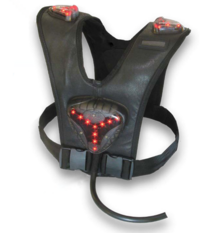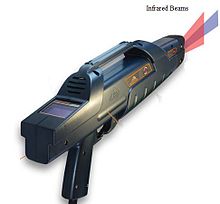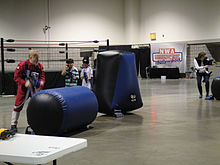Laser tag
Laser Tag (including laser tag , laser game or laser tag called) is a game in which two or more players try to perform various tasks on a special course to meet or in several rooms. Some providers focus on sporting ambition. There two teams compete against each other, similar to other sports. The team has to score the most points and thus win the game. Harmless infrared signal generators (called phasers) are available as an aid. The locations where the game is played, be as Arena or Laserdrom (Engl. Laserdrome ), respectively. The internationally common name for the game is laser tag . Most of the time, Lasertag is a team point game that requires team play and skill. Most laser tag courses are equipped with black light and also offer challenging obstacles.
Technical Equipment
Indoor
Each player wears sensors on his body, the most common are vests with front, back and shoulder sensors, optionally the phaser itself has one or more sensors. If a sensor is hit by an infrared beam (or laser beam), the computer evaluates this hit and the player is given a point deduction, elimination or temporary deactivation. Depending on the system and game, it is quite possible that several hits cumulatively affect the duration of the deactivation of the vest.
Similar to a laser pointer, a laser beam supports the player in finding the target. Since there are several manufacturers, there are different signal transmission techniques.
In general, there are three forms of signal transmission that are most commonly used:
- Laser signal - the hit is signaled by a "phaser", which is similar to a one-hand barcode scanner. A pulsed laser beam is also used here. However, since it would be quite difficult to hit a light sensor of the same size with a 2 mm laser point, the vest has a strand of thin fiberglass strands. These fibers then come together in a bundle on a socket in front of a photodiode, which captures the laser light pulses.
- Infrared signal - This system works on the principle of a remote control. An infrared signal is transmitted either from the phaser to the sensor on the vest or from the vest to the phaser.
- ID scanning - with this technology, no signal is sent when the "shot" is taken (only the laser pointer is triggered to simulate a shot), but the vests continuously transmit their ID number (as a digital signal) and the phasers scan this signal. Pulling the trigger while an ID is being scanned is considered a hit. Scanning enables advanced functions that can only be achieved if the devices know that they are currently “in their sights”. Long-term effects such as target acquisition by missiles, “suction” of energy or points, automatic target systems in the arena or similar game events work in this way.
The phaser has a screen in some cases ; some manufacturers use monochrome LCDs and other touchscreens . Additional hardware on the playing field is now inevitable and offers a wide range of game variants and special effects. They interact with the player and provide feedback through audiovisual signals.
- Touchscreen - In a few arenas, phasers are equipped with touchscreens that give the player real-time information on hits, points, available weapon systems, gimmicks , and more.
- Targets - It is customary that on the pitch additional targets (English targets.) Be set up, which can be marked to additional points or similar.. to obtain.
- Base - Base Stations (. English Base Stations) enable game variations such. B. Capture the flag . For example, in team play game variants, base stations can be protected from counter hits.
- Gamestation - A permanently installed touchscreen on the playing field makes it possible to pick up gimmicks while the game is in progress. For new game variations, the game station can communicate with the player's vest via an interactive interface.
Outdoors
Almost all outdoor systems work with headbands to record hits. Two to four sensors are attached to the headbands, making the player accessible from all sides. If a player is hit by another at the sensors, the hit is evaluated, which, as with the indoor system, can lead to the player being eliminated or loss or gain of points.
Many outdoor systems do not use radio transmission, as computers are often not installed in the fields to coordinate the transmissions. Newer systems, on the other hand, use computer-aided radio transmission to enable a similar level of interactivity as the indoor systems. In addition, the high-end devices can also use GPS signals outdoors in order to guide the teams or trigger events (e.g. entering a certain area).
The outdoor systems mostly work with IR LEDs and lenses, but a few systems also work with IR laser units, which usually allow longer ranges and require more precise aiming. All known outdoor systems can also be used indoors thanks to their adjustable output, which gives them a broader range of uses.
Technical specifications
LaserMaxx provides the following technical information:
- Shooting distance in indoor play areas is typically 12-15 m. The accuracy has been increased to 35 m.
- Up to 64 players in up to 6 teams can compete against each other in one game.
- There is a continuous radio link between the computer and the player's vest.
- One computer supports synchronized games in several arenas.
- Jacket weight 2.3 kg.
Other manufacturers offer other technical basics, such as outdoor-capable systems with ranges of over 50 meters. The field of technical features in commercial devices is broad.
Game variants
There are many different game variants, for example:
- Solo : everyone against everyone, without division into teams
- Retro Zed : two or more teams compete against each other and have to try to get as many hits as possible on the opposing team's vest. The winner is the team that has either scored the most points or has the better ratio of hits to goals
- Capture the Flag : The opposing teams try to defend their own base and at the same time mark the enemy base with fire. The team that has the most hits or the best hit ratio wins. This is the virtual conquest of the flag, as it is known in paintball.
- Darkgames : Since a Laserdrom is a virtual, closed landscape (hall), you can play this game in complete darkness. Only signal lamps on the vests or full-body suits show the team memberships.
- Darkgames stealth : The stealth variant is a solo game. Several players move into a completely darkened arena. The lights on the vests or full body suits are also switched off. Everyone plays against everyone and can only rely on their hearing to find their opponents. The player who scored the most hits wins.
- Armageddon : A multi-system tournament format. Tournament games are held in several centers over a weekend. The crucial thing is that at least three different laser tag systems must be used. This ensures that no team has a home advantage. An Armageddon usually begins on a Friday evening and ends early Sunday morning.
- Team Elimination Without Charging : A format often used for tournaments too. Two teams compete against each other and try to achieve the higher number of points by hitting the opposing team many times. Additional modes are often activated during the game, such as a short-term stealth mode. With that, the lights of the vests are deactivated, which is a significant advantage in the dark halls.
- Team elimination with charging : As with team elimination, two teams compete against each other. The main difference to the variant without charging is that each player only has a limited number of markings and has to run back to the base after they have been used. This mode is particularly preferred in tournaments because it increases the tactical aspect of the game.
- King of the Hill : Each player starts with a fixed number of possible hits. If this player is hit according to the maximum number of hits, he / she must leave the field of play.
In addition to these typical types of games for indoor laser tags, based on various computer games, additional game modes have also been developed for outdoor laser tag providers. Due to the more extensive terrain and playing fields, the following game modes are available:
- "VIP / Bodyguard / Escort": Here a person has to be brought through an area that is being defended by the opposing team - in this scenario little or no damage may be done to the VIP.
- "Bomb Defusion": With the help of computer-controlled dummies, the defusing of a bomb is simulated, which has to be found and captured beforehand. The mitigation is based on mathematical tasks, time-critical concentration exercises or the implementation of codes.
- "Zombie Game": The game mode can only be found with one provider and is based on two groups, the balance of which changes when players are shot out of the game and come back as a zombie.
- “Domination”: One or more control points must be found, captured and defended by the competing teams. The checkpoints automatically count the time for the last team to conquer the point. The team with the most control points for the longest time wins the game.
- Role-playing games: Some systems offer role-playing games in which the players, depending on their character, have different skills. One player can provide his teammates with life energy, the next with ammunition, etc.
Differentiation between paintball and airsoft
At first glance, Laser Tag is comparable to paintball or airsoft . However, no gelatine or plastic balls are shot. In contrast to this, the aim of Laser Tag is to use your phaser to target another vest on which the sensors are attached in order to temporarily deactivate it and thus collect points. In addition, due to the technology, there are also game variants that could not be implemented in this form either for paintball or for airsoft. For example, the data that is recorded can be summarized into precise statistics, winning parameters and other game-critical parameters. In some cases, the systems from various manufacturers also offer additional devices that take on various tasks in the game and thus, for example, revive the players, distribute new ammunition, cause temporary power-ups and more. This is not possible with analog games such as paintball or airsoft.
Unlike paintball, Laser Tag does not require any special protective clothing, normal everyday clothing is sufficient. Because there are no projectiles, the inhibition threshold for players to shoot other people is lower, as they do not have to worry about bruises, bruises or, as with paintball, heavy soiling. In contrast to paintball, this enables younger people for whom paintball is still too hard to participate. Paintball can be used from the age of 18, laser tag earlier depending on the variant. The abstraction of the game arenas and phasers of the social acceptance of Laser Tag also helps here.
Since with the laser tag all players usually receive the same equipment that is provided by the organizer, the so-called “gear level” (i.e. the quality and quantity of the equipment) is not decisive for the outcome of the game or the player's success. While in the aforementioned sports paintball and airsoft the equipment often decides whether to win or lose, with the laser tag this aspect is less important and all players can play with the same requirements from the start.
Legal
There is now consensus in the case law that Laser Tag can at least not be banned by the administrative authorities of the municipalities and states due to existing legal possibilities. Rather, in the opinion of the Federal Administrative Court (BVerwG), it is incumbent on the legislature itself to evaluate the commercial operation of a laser game as, literally, a new form of professional practice and to create the legal basis for it or against it.
Nonetheless, the BVerwG stated in the same judgment that the war-like design of the facility affected in the judgment was incompatible with the human dignity guaranteed in the Basic Law due to the trivialization of violence . Following the judgment, the BVerwG also obtained an opinion from the European Court of Justice (ECJ) as to whether such a game could be banned at national level (and thus in Germany) due to the overriding legal provisions of the EU .
In the opinion of the European Court of Justice, however, the agreements under European law do not preclude the prohibition of such a game at national level.
Situation in Germany
Basically, the legislature in Germany differentiates between laser tags and paintball. In terms of urban development law, laser tag systems are considered sports facilities or other commercial operations in Germany, which means that there are different requirements in terms of building law. Due to the judgment of the OVG Rhineland-Palatinate of September 28, 2016 (8 A 10338/16), laser tag systems are assessed as typical amusement facilities in the core area, which are therefore not generally permitted in commercial areas, for example.
In general, the operation of a laser tag system is not prohibited under commercial law in Germany. At the local level, applications are checked by the responsible trade office. Likewise, the building authority and youth protection have a say and should be consulted in order to meet any local requirements. Age limits are often set according to the respective game content. Classic laser tags with vests in a futuristic look are usually lighter and also approved for younger players. The more realistic systems (indoors or outdoors) are usually also approved if they are 18+. Since there is not yet a uniform national regulation, the local authorities decide on approval or denial - a general statement cannot be made on this.
It has been observed for some time, however, that the authorities are becoming better informed about what Laser Tag is and are implementing the relevant instructions from the city council. This directive currently only relates to the building law, according to which the arenas are to be classified as other commercial operations if an application is made. The degree of reality of the playground equipment is only relevant if the equipment is used in visible areas (see regulations for fake weapons / airsoft and paintball). Otherwise there are no regulations that prohibit or prefer certain optics. As a result, various directions are currently developing, which are mainly related to the technical progress of the equipment.
The authorities often focus on the protection of minors. Public order and youth welfare offices assess access for children and young people according to different aspects.
Military operation
This technology is also used in the military to simulate a battle. The soldier's weapon (as well as other military equipment) is modified with a so-called SIM attachment and shot with blank cartridges. The US weapons training system MILES and the German training device duel simulator are two such systems.
Web links
swell
- ↑ Duden: Laserdrom , after the English word laserdrome , from laser and -drome from Greek drómos = race track, word formation similar to that of the hippodrome .
- ↑ Technical LaserMaxx, Bilthoven, Netherlands.
- ↑ BVerwG: "Ban on a laser game", NVwZ 2002, 598.
- ↑ ECJ: NJW 2005, 736.


